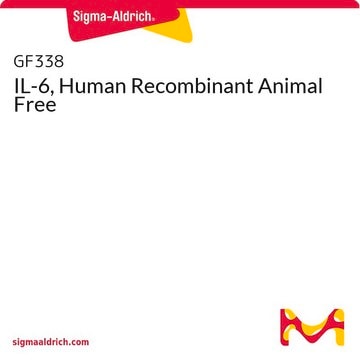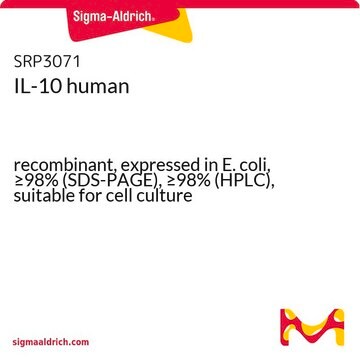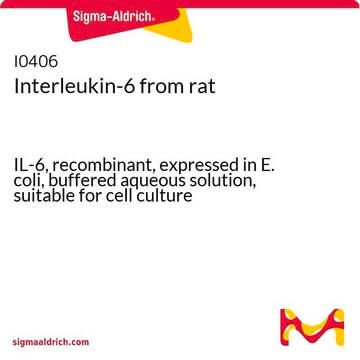SRP3096
Interleukin-6 human
Animal-component free, recombinant, expressed in E. coli, suitable for cell culture
Synonim(y):
Interleukin-6 human, IL-6
About This Item
Polecane produkty
pochodzenie biologiczne
human
Poziom jakości
rekombinowane
expressed in E. coli
Próba
≥95% (SDS-PAGE)
Postać
lyophilized
siła działania
≤2.0 ng/mL ED50
masa cząsteczkowa
20.9 kDa
opakowanie
pkg of 100 μg
pkg of 20 μg
metody
cell culture | mammalian: suitable
zanieczyszczenia
≤1 EU/μg endotoxin, tested
numer dostępu UniProt
Warunki transportu
wet ice
temp. przechowywania
-10 to -25°C
informacje o genach
human ... IL6(3569)
Szukasz podobnych produktów? Odwiedź Przewodnik dotyczący porównywania produktów
Powiązane kategorie
Opis ogólny
Zastosowanie
Działania biochem./fizjol.
Opakowanie
Sekwencja
Postać fizyczna
Rekonstytucja
Hasło ostrzegawcze
Warning
Zwroty wskazujące rodzaj zagrożenia
Zwroty wskazujące środki ostrożności
Klasyfikacja zagrożeń
Eye Irrit. 2 - STOT SE 3
Organy docelowe
Respiratory system
Kod klasy składowania
11 - Combustible Solids
Klasa zagrożenia wodnego (WGK)
WGK 1
Temperatura zapłonu (°F)
Not applicable
Temperatura zapłonu (°C)
Not applicable
Certyfikaty analizy (CoA)
Poszukaj Certyfikaty analizy (CoA), wpisując numer partii/serii produktów. Numery serii i partii można znaleźć na etykiecie produktu po słowach „seria” lub „partia”.
Masz już ten produkt?
Dokumenty związane z niedawno zakupionymi produktami zostały zamieszczone w Bibliotece dokumentów.
Klienci oglądali również te produkty
Protokoły
MTT assay protocol for measuring cell viability, proliferation and cytotoxicity. Instructions for MTT reagent preparation and examples of applications.
Protokół testu MTT do pomiaru żywotności, proliferacji i cytotoksyczności komórek. Instrukcje przygotowania odczynnika MTT i przykłady zastosowań.
Perform colorimetric assays for nonradioactive quantification of cellular proliferation, viability, and cytotoxicity for adherent or suspension cells cultured in 96-well microplates.
Przeprowadzanie testów kolorymetrycznych w celu nieradioaktywnej kwantyfikacji proliferacji, żywotności i cytotoksyczności komórek przylegających lub zawiesinowych hodowanych w 96-dołkowych mikropłytkach.
Nasz zespół naukowców ma doświadczenie we wszystkich obszarach badań, w tym w naukach przyrodniczych, materiałoznawstwie, syntezie chemicznej, chromatografii, analityce i wielu innych dziedzinach.
Skontaktuj się z zespołem ds. pomocy technicznej












